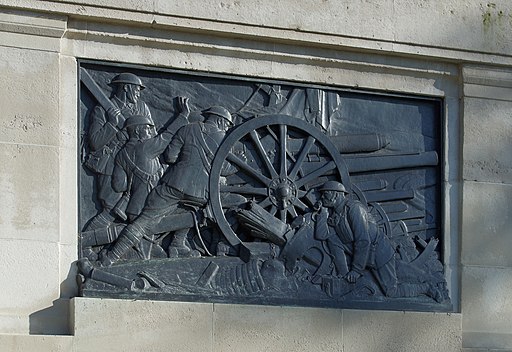The Guards Memorial is located at the edge of St James Park and Horse Guards. It was built to commemorate those who lost their lives whilst serving with the Guards Division during the First World War.
 |
| Guards Memorial |
The 12 metre high Portland stone memorial was designed by HC Bradshaw and unveiled by the Duke of Connaught on the 16th October 1926.
The memorial features five bronze sculptured Guardsmen and carved stone badges of the Foot Guards Regiments; Grenadier, Scots, Irish, Welsh, Coldstream, Guards.
 |
Guards Memorial - Bronze Statues of Guardsmen
Grenadier Scots Welsh Irish Coldstream
|
 |
Guards Memorial - Bronze Statues of Guardsmen
Grenadiers Scots Welsh Irish Coldstream
|
The inscription on the face of the memorial was written by Rudyard Kipling, who's son Jack had been killed serving with the Irish Guards in September 1915 at Loos.
TO THE GLORY OF GOD
AND IN THE
MEMORY OF THE
OFFICERS WARRANT OFFICERS
NON COMMISSIONED OFFICERS &
GUARDSMEN OF HIS MAJESTY'S
REGIMENTS OF FOOT GUARDS
WHO GAVE THEIR LIVES
FOR THEIR
KING AND COUNTRY DURING THE
GREAT WAR 1914–1918 AND OF THE
OFFICERS WARRANT OFFICERS
NON-COMMISSIONED OFFICERS AND
MEN OF THE
HOUSEHOLD CAVALRY
ROYAL REGIMENT OF ARTILLERY
CORPS OF ROYAL ENGINEERS
ROYAL ARMY SERVICE CORPS ROYAL
MEDICAL CORPS AND OTHER
UNITS WHO WHILE
SERVING THE
GUARDS DIVISION IN FRANCE &
BELGIUM 1915–1918 FELL WITH
THEM IN
THE FIGHT FOR THE WORLD'S FREEDOM.
 |
| Guards Memorial Inscription |
The memorial also bears the name of the units of the Guards Division and their Battle Honours. A further inscription was added after World War Two which also serves as a memorial to those lost in more recent conflicts.
THIS MEMORIAL ALSO
COMMEMORATES ALL THOSE MEMBERS
OF THE HOUSEHOLD DIVISION WHO DIED IN THE
SECOND WORLD WAR
AND IN THE SERVICE OF THEIR COUNTRY SINCE 1918
The inscription on the memorial remembers the Officers, WO's, SNCO's and men of the supporting arms and logistics units that were part of the Guards Division, which includes the Royal Regiment of Artillery.
A panel at the rear of the memorial recognises the contribution of the Royal Artillery, portraying an 18 pounder gun in action.
Guards Divisional Artillery WW1
The Guards Division was formed in France in August 1915 by transferring all the Guards Battalions from the Divisions with which they were serving into the new formation.
1st Guards Brigade
2 Grenadier / 2 Coldstream / 3 Coldstream / 1 Irish
2nd Guards Brigade
3 Grenadier / 1 Coldstream / 1 Scots / 2 Irish
3rd Guards Brigade
1 Grenadier / 4 Coldstream / 2 Scots / 1 Welsh
Divisional Pioneers
4 Coldstream
When the Guards Division formed, the bulk of the divisional artillery was brought in from the 16th (Irish) Division. The 74th / 75th / 76th Brigades Royal Field Artillery were formed in September 1914 by the Irish Command as New Army (K2) units. They moved to Aldershot, then on to Salisbury Plain, equipping with 18 pounders. They transferred to the Guards Division in August 1915.
The fourth RFA Brigade in the Division was the 61st (Howitzer) Brigade RFA, a New Army (K1) unit which transferred in from the 11th (Northern) Division. The 61st Brigade RFA formed as three x 6 gun batteries. In February 1915 the Brigade re-organised into four x 4 gun batteries. It came under the command of the Guards Division in August 1915, when the 11th Division was ordered to the Mediterranean.
The Divisional Ammunition Column was originally raised by the 16th (Irish) Division, transferring to the Guards Division, September 1915. Three Medium Trench Mortar Batteries (X / Y / Z) were formed in March 1916, and a Heavy Trench Mortar Battery (V Guards) in May.
The 61st (Howitzer) Brigade was broken up in November 1916 and the units left the Division. D/61 Battery would transfer to 50th (Northumbrian) Division.
The 76th Brigade would leave the Guards Division in January 1917 to become an Army Field Brigade.
520 (Household) Siege Battery
The inscription on the memorial includes the Household Cavalry who provided a cavalry squadron to the Guards Division from August 1915 to June 1916.
Later in the war, personnel from the Household Cavalry would form a Siege Battery [520 (Household) Siege Battery RGA], which served on the Western Front.
The 520 SB was formed in November 1917 and sailed from Southampton on the March 31st 1918, arriving in Le Havre the following day. Equipped with four x 6 inch guns, the battery joined First Army (located Armentieres to Arras) on 18th April 1918, becoming an army level resource.










.JPG)




















